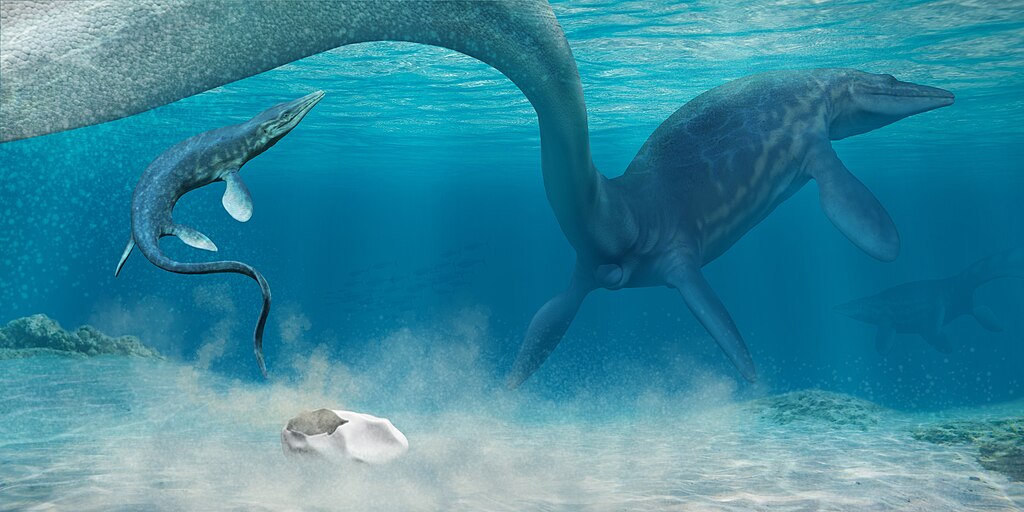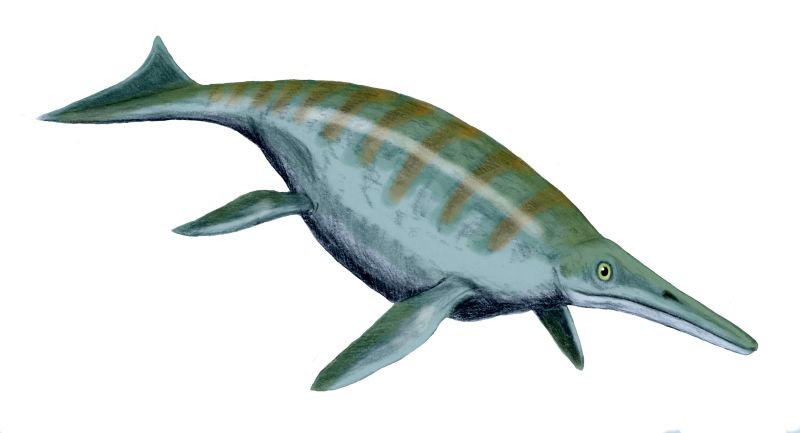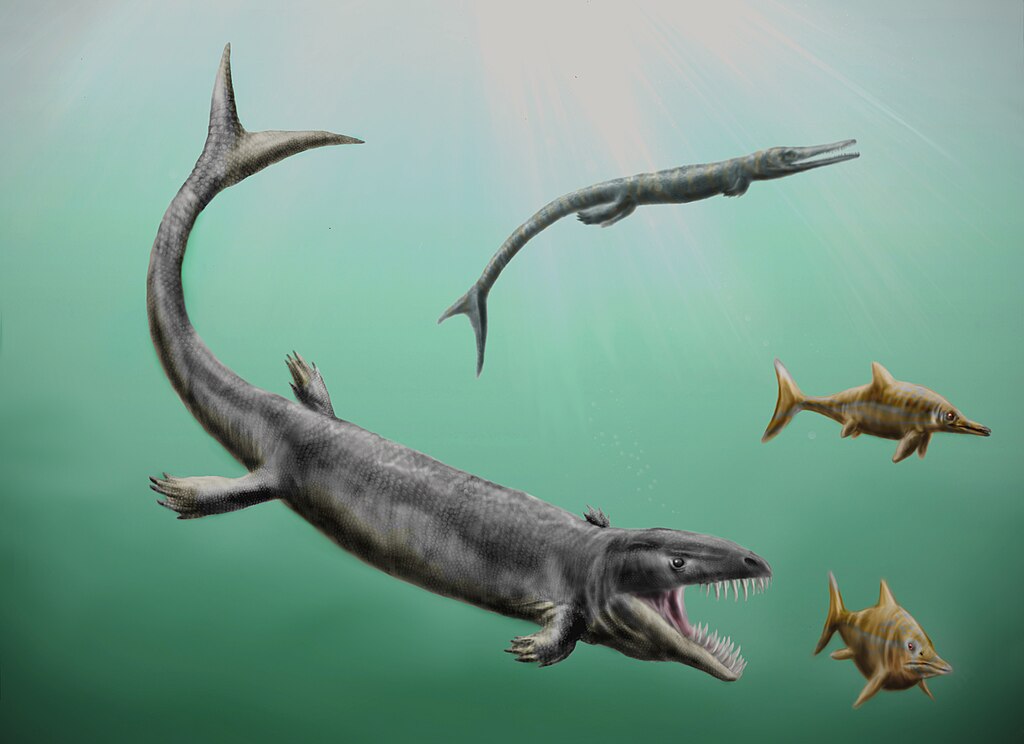The depths of Earth’s primordial oceans once teemed with marine predators so formidable that they would eclipse many of today’s apex ocean hunters. During the Mesozoic Era (252-66 million years ago), while dinosaurs dominated the land, the seas belonged to a spectacular array of reptilian creatures that had returned to aquatic lifestyles. Ichthyosaurs with their dolphin-like agility, pliosaurs with crushing jaws and massive flippers, and mosasaurs with their serpentine bodies ruled as apex predators in marine ecosystems worldwide. These magnificent creatures evolved remarkable adaptations for life at sea, developing streamlined bodies, powerful propulsion systems, and specialized hunting abilities. Their fossils, discovered across continents, offer fascinating glimpses into an underwater world where these massive predators competed and thrived for millions of years before their eventual extinction. This article explores the evolution, anatomy, behavior, and ecological significance of these spectacular marine reptiles that once ruled Earth’s oceans.
The Aquatic Revolution: When Reptiles Returned to the Sea

The story of marine reptiles begins with one of evolution’s most remarkable reversals – the return of land-dwelling vertebrates to aquatic environments. Approximately 250 million years ago, in the aftermath of the devastating Permian-Triassic extinction event, various reptile lineages independently evolved adaptations for marine life. This transition wasn’t unprecedented in evolutionary history, as mammals would later follow a similar path (resulting in whales and dolphins), but the scale and diversity of these reptilian adaptations were extraordinary. These animals descended from terrestrial ancestors who gradually developed more streamlined bodies, limbs modified into flippers, and physiological changes to handle deep diving and salt regulation. Fossil evidence reveals transitional forms showing the gradual movement from shore-dwelling creatures to fully pelagic predators, highlighting one of evolution’s most dramatic examples of adaptive radiation. This aquatic revolution would lead to the three major groups we recognize today as the dominant marine reptiles of the Mesozoic: ichthyosaurs, pliosaurs, and mosasaurs.
Ichthyosaurs: The Dolphin Doppelgängers

Ichthyosaurs represent one of the most spectacular examples of convergent evolution in the fossil record, developing bodies remarkably similar to modern dolphins and tuna despite having no direct relationship to either group. First appearing in the Early Triassic (approximately 250 million years ago), these marine reptiles rapidly evolved into highly specialized ocean hunters with streamlined, fish-shaped bodies, dorsal fins, and vertical tail flukes that enabled powerful swimming capabilities. Advanced adaptations included large eyes supported by bony rings that likely permitted deep diving and hunting in low-light conditions, making them formidable visual predators. Some species, like Temnodontosaurus, reached lengths exceeding 12 meters, while others remained relatively small at just 1-2 meters. Perhaps most remarkably, ichthyosaurs evolved true viviparity (live birth), with numerous fossils showing mothers in the process of giving birth or with embryos preserved inside their bodies – clear evidence they had completely abandoned any return to land for reproduction. Their specialized biology made them among the most perfectly adapted marine vertebrates in Earth’s history, dominating oceans worldwide for over 150 million years before their extinction in the Late Cretaceous.
Pliosaurs: Short-Necked Monsters With Devastating Bite Force

Among the most fearsome predators to ever patrol Earth’s oceans, pliosaurs evolved as a specialized branch of plesiosaurs, characterized by their massive heads, short necks, and powerfully built bodies. These marine reptiles possessed four large, wing-like flippers that they used in a flying motion underwater, providing remarkable maneuverability despite their substantial size. The largest pliosaurs, such as Pliosaurus kevani and the infamous “Predator X” (Pliosaurus funkei), reached estimated lengths of 10-15 meters with skulls exceeding 2 meters long. Their jaws were armed with interlocking conical teeth, some as large as cucumbers, capable of delivering a catastrophic bite force estimated to exceed that of Tyrannosaurus rex. Biomechanical studies suggest the largest pliosaurs could generate bite forces up to 33,000 pounds, allowing them to easily dismember large prey. Stomach contents from exceptionally preserved specimens reveal they consumed everything from fish and ammonites to other marine reptiles, solidifying their position as apex predators in Jurassic and Early Cretaceous oceans. Their hydraulic body design created a perfect storm of power, speed, and maneuverability that made them among the most effective predators in marine history.
Mosasaurs: The Final Rulers of the Mesozoic Seas

Mosasaurs, the last great marine reptile dynasty to evolve during the Mesozoic, were formidable predators that dominated ocean ecosystems during the Late Cretaceous period. Unlike ichthyosaurs and pliosaurs, mosasaurs were relatively late arrivals to marine environments, first appearing about 98 million years ago and evolving from semi-aquatic lizards closely related to modern monitor lizards and snakes. Their evolutionary transition is well-documented in the fossil record, showing the gradual transformation from shore-dwelling reptiles to fully marine predators. Characterized by their elongated bodies, powerful tails, and paddle-like limbs, mosasaurs propelled themselves through water with sinuous, snake-like movements augmented by their flippers. Their jaws featured double-hinged construction similar to that of snakes, allowing them to swallow large prey whole, while additional teeth on their pterygoid bones (roof of the mouth) helped secure struggling victims. Mosasaurs exhibited remarkable diversity, with over 40 known species ranging from the 3-meter Carinodens to giants like Mosasaurus hoffmannii reaching 17 meters in length. They persisted until the very end of the Cretaceous, finally perishing alongside non-avian dinosaurs in the mass extinction event 66 million years ago.
Evolutionary Arms Race: Adapting to Life in the Open Ocean

The transition from land to sea presented enormous challenges that drove the remarkable adaptations seen in Mesozoic marine reptiles. Each group independently evolved streamlined bodies that minimized drag while maximizing propulsion efficiency, though they approached this problem in distinct ways. Ichthyosaurs developed a thunniform (tuna-like) body shape with crescent-shaped tails generating thrust through vertical movement, similar to modern sharks and dolphins. Pliosaurs evolved four powerful flippers that “flew” through water in coordinated movements, providing both speed and exceptional maneuverability. Mosasaurs retained a more lizard-like body plan but developed flattened, powerful tails for serpentine swimming. Beyond locomotion, these creatures faced physiological challenges including salt balance, pressure regulation during deep dives, and oxygen efficiency. Scientific evidence suggests many developed specialized metabolism and possibly thermoregulation capabilities approaching those of modern endothermic (“warm-blooded”) animals. The presence of countercurrent heat exchangers in some species indicates adaptations for maintaining higher body temperatures than the surrounding water, potentially enabling them to hunt in colder, deeper waters or sustain higher activity levels than typical reptiles. This evolutionary arms race produced increasingly sophisticated marine predators throughout the Mesozoic era.
Sensory Systems: How Sea Monsters Detected Their Prey

Mesozoic marine reptiles evolved sophisticated sensory adaptations for hunting in the three-dimensional marine environment, each group developing specialized systems suited to their ecological niche. Ichthyosaurs possessed the largest eyes relative to body size of any vertebrate group, with some species having eyeballs exceeding 25 centimeters in diameter, supported by bony sclerotic rings that maintained eye shape under pressure. These enormous eyes contained abundant rod cells, suggesting excellent vision in low-light conditions for hunting at depth or during nighttime. Pliosaurs developed complex neurovascular channels in their snouts that likely housed electroreceptive or mechanosensory organs similar to those in modern crocodilians, allowing them to detect prey movements even in murky water. Mosasaurs, with their snake-like ancestry, may have utilized specialized scale sensory organs for detecting water pressure changes and vibrations from nearby prey. Additionally, isotopic studies of their inner ear structures indicate that many marine reptiles had excellent directional hearing underwater, vital for both hunting and social interactions. Some species show evidence of specialized salt glands near their orbits, similar to those in modern sea turtles, which would have helped them process the high salt content of marine prey while maintaining osmotic balance.
Prehistoric Nurseries: Reproduction in Marine Reptiles

The reproductive strategies of Mesozoic marine reptiles represent one of their most fascinating evolutionary innovations, as they solved the reptilian challenge of egg-laying while living permanently at sea. Ichthyosaurs evolved true viviparity (live birth), completely eliminating any need to return to land, with multiple fossil specimens captured in the moment of giving birth, the young emerging tail-first to prevent drowning during delivery. Their embryos developed within the mother’s body, receiving nourishment directly through a placenta-like connection rather than from yolk, similar to modern mammals. Plesiosaurs (including pliosaurs) also gave birth to live young, but appeared to have produced fewer, larger offspring, suggesting significant parental investment in each juvenile. Mosasaurs similarly evolved live birth, with fossil evidence showing they likely gave birth to multiple young in open water. Isotope analysis of juvenile specimens indicates some species may have utilized specific nursery areas in shallow, protective waters similar to modern shark nurseries, where young could grow with reduced predation risk. These reproductive adaptations represent complete evolutionary solutions to aquatic living, eliminating the final tie to terrestrial environments and allowing these reptiles to exploit fully pelagic lifestyles across the world’s oceans.
The Massive Monster: Kronosaurus, King of the Pliosaurs

Among the most formidable marine predators of all time, Kronosaurus queenslandicus has captivated paleontologists and the public alike since its discovery in Australia’s Early Cretaceous deposits. This colossal pliosaur stretched 10-11 meters in length with a skull measuring a staggering 2.7 meters, making it among the largest pliosaur species known to science. Its massive jaws contained conical teeth exceeding 30 centimeters in length, with specialized teeth at the front for grabbing prey and rear teeth designed for slicing through flesh. Biomechanical analysis of its skull suggests Kronosaurus could generate bite forces approaching 33,000 newtons, more than twice that estimated for Tyrannosaurus rex. Its four powerful, paddle-like limbs may have exceeded 3 meters in length, providing tremendous propulsion through underwater “flying” movements. Kronosaurus’s ecological role as an apex predator is confirmed by stomach contents preserving partially digested remains of turtles, other marine reptiles, and large fish. Recently discovered specimens have revised our understanding of its proportions, suggesting a somewhat shorter neck and more hydrodynamic body than depicted in older reconstructions, emphasizing its specialized adaptations for pursuing and overpowering large prey in Australia’s ancient Eromanga Sea approximately 110 million years ago.
Shonisaurus: The Leviathan Ichthyosaur

Patrolling the Late Triassic oceans approximately 215 million years ago, Shonisaurus popularis represents one of the most spectacular ichthyosaurs ever discovered and potentially the largest of its kind. First unearthed in Nevada’s Luning Formation (now protected as Berlin-Ichthyosaur State Park), this behemoth reached estimated lengths of 15-21 meters, comparable to a modern sperm whale, with a streamlined body optimized for sustained, efficient swimming. Unlike smaller ichthyosaur species with their sharp, interlocking teeth, Shonisaurus evolved relatively small, widely-spaced teeth, suggesting it may have been specialized for feeding on soft-bodied prey like squid, using suction feeding rather than active prey capture. Its massive eyes, potentially the largest of any vertebrate in history, would have allowed it to hunt effectively in the dim light of deeper waters. Remarkably, Nevada’s fossil sites have yielded remains of at least 37 individuals in close proximity, leading some paleontologists to speculate these creatures may have died during a mass stranding event or while feeding in a productive but dangerous shallow area. Recent research has revealed that ichthyosaurs of this size likely maintained body temperatures significantly higher than ambient water, possibly approaching endothermy (warm-bloodedness), allowing them to inhabit colder waters and maintain higher activity levels than typical reptiles.
Tylosaurus: The Ultimate Mosasaur

Tylosaurus prowled the Late Cretaceous Western Interior Seaway of North America as one of the most fearsome mosasaurs ever to evolve, combining massive size with specialized predatory adaptations. Growing to lengths of 12-15 meters with a distinctively elongated, reinforced snout used as a battering ram to stun prey, this marine lizard represented the culmination of mosasaur evolution. Unlike some of its relatives, Tylosaurus possessed relatively large, conical teeth designed for seizing rather than crushing, allowing it to tackle diverse prey including fish, ammonites, seabirds, and even other marine reptiles. Remarkably preserved specimens have been found with stomach contents intact, revealing that Tylosaurus consumed virtually anything it could overpower, including birds, sharks, bony fish, and even smaller mosasaurs. Its powerful tail featured an expanded, shark-like fin at the end for generating powerful forward thrust, while its limbs had evolved into broad, paddle-like flippers providing stability and maneuverability. The skull of Tylosaurus featured a distinctive ball-and-socket joint in the middle, allowing it to bend and flex when tackling large prey, spreading out impact forces while maintaining a secure grip with its formidable teeth. As one of the last and largest mosasaurs, Tylosaurus represents the apex of mosasaur evolution before their extinction at the end of the Cretaceous period.
Liopleurodon: Separating Fact from Fiction

Few prehistoric marine creatures have suffered more from sensationalized portrayals than Liopleurodon, a genus of pliosaur that lived during the Middle to Late Jurassic period, approximately 160-155 million years ago. While impressive by any standard, measuring approximately 6-7 meters in length based on complete fossil specimens, this predator’s size has been dramatically exaggerated in popular media, most notably in the BBC documentary “Walking with Dinosaurs,” which depicted it as a 25-meter sea monster. This misrepresentation stemmed from fragmentary remains that were incorrectly scaled, creating an enduring myth about the animal’s proportions that continues to circulate widely. The actual Liopleurodon was nonetheless a formidable hunter, with a large skull exceeding 1.5 meters in length, equipped with distinctive teeth that featured three cutting edges instead of the typical round cross-section seen in most pliosaurs. Isotopic analysis of Liopleurodon fossils reveals they were likely endothermic to some degree, maintaining elevated body temperatures that enabled sustained high-speed swimming and active predation. Their four powerful flippers provided both propulsion and exceptional maneuverability, allowing them to execute quick turns when pursuing agile prey in the shallow epicontinental seas covering parts of modern Europe during the Jurassic period.
Ecological Impact: How Marine Reptiles Shaped Ocean Ecosystems

The dominance of marine reptiles during the Mesozoic fundamentally reshaped ocean ecosystems, establishing complex food webs with these new vertebrate predators occupying diverse niches at the top of marine trophic systems. Their evolutionary radiation coincided with significant changes in marine invertebrate communities, particularly affecting cephalopod evolution, as ammonites and belemnites developed more sophisticated defensive adaptations in response to predation pressure. Different marine reptile groups occupied complementary ecological roles: ichthyosaurs primarily pursued fast-moving fish and squid in open water, pliosaurs targeted larger prey, including other marine reptiles, and mosasaurs evolved diverse feeding specializations from shellfish-crushing to pursuit predation. This partitioning of resources allowed multiple large predator types to coexist in the same marine ecosystems without direct competition. Paleontological evidence suggests marine reptiles also influenced the evolution of bony fish, with many fish groups developing faster swimming capabilities, better camouflage, or



